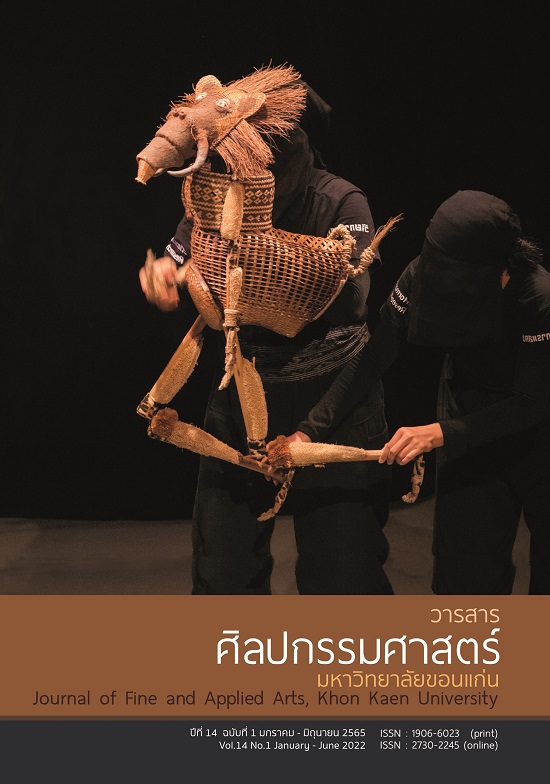A Musical of Khlui - Pieng - Or Solo : A Case Study of Kru Jumniean Srithaiphan’s Kraw - Nai Song Chan
Main Article Content
Abstract
Phleng Kraw - Nai Song Chan is a song with a kind of beat called “Song Mai”. This song is performed by conducting a melody with six sounds: Do, Re, Ti, Me, La and Fa. In this study, the author has given a specific example of Phleng Look - Yon using the first sound called “Do” to understand the solo of Khlui - Pieng - Or. A solo of Phleng Kraw - Nai requires specific technique which is different from the basic melody.
A solo of Khlui - Pieng - Or using Phleng Kraw - Nai a case study Kru Jamniean Srithaiphan is performed with a solo melody. It is based on a melodic pattern of the basic melody to create the solo. The non - rhythmic style with specific playing techniques are used to create an aesthetic in a song. These techniques are “Prib” and “Sabad” (flicking) with the sounds. A solo of Khlui - Pieng - Or using Phleng Kraw - Nai a case study Kru Jamniean Srithaiphan is a melodic solo and requires advanced performing skill.
Article Details

This work is licensed under a Creative Commons Attribution-NonCommercial-NoDerivatives 4.0 International License.
Content and information in articles published in the Journal of Fine and Applied Arts of Khon Kaen University is regarded as the opinion and sole responsibility of the author(s) directly; therefore, editors are not obliged to agree to or share any responsibility with regard to the content and information that appears within these articles.
All articles, information, content, image, etc. that have been published in the Journal of Fine and Applied Arts of Khon Kaen University is the copyright of the Journal of Fine and Appllied Arts of Khon Kaen University. Any person or organization who wishes to distribute all or parts of the articles for further dissemination or other usage must first receive permission from the Journal of Fine and Applied Arts of Khon Kaen University before proceeding to do so.
References
เฉลิมศักดิ์ พิกุลศรี. (2530). สังคีตนิยมว่าด้วยดนตรีไทย. กรุงเทพฯ : โอเดียนสโตร์.
ธนิต อยู่โพธิ์. (2523). เครื่องดนตรีไทยพร้อมด้วยตำนานการผสมวงมโหรีปี่พาทย์และเครื่องสาย. กรุงเทพฯ : กรมศิลปากร.
ธนิต อยู่โพธิ์. (2544). เครื่องดนตรีไทย. กรุงเทพฯ : กรมศิลปากร.
พงษ์ศิลป์ อรุณรัตน์. (2554). ปฐมบทดนตรีไทย. นครปฐม : โรงพิมพ์มหาวิทยาลัยศิลปากร.
มนตรี ตราโมท, และวิเชียร กุลตัณฑ์. (2523). ฟังและเข้าใจเพลงไทย. กรุงเทพฯ : โรงพิมพ์ไทยเขษม.
มนตรี ตราโมท. (2545). คำบรรยายวิชาดุริยางคศาสตร์ไทย. กรุงเทพฯ : กรมศิลปากร.
ราชบัณฑิตยสถาน. (2556). พจนานุกรมฉบับราชบัณฑิตยสถาน พ.ศ. 2554. กรุงเทพฯ : ราชบัณฑิตยสถาน.
วิเชียร กุลตัณฑ์. (2526). ความรู้ทั่วไปเกี่ยวกับดนตรีไทย. กรุงเทพฯ : อัมรินทร์การพิมพ์.
ศูนย์สังคีตศิลป์ ธนาคารกรุงเทพ. (2537). เชิดชูเกียรติ 100 ปี พระยาภูมีเสวิน (จิตร จิตตเสวี) ผู้เชี่ยวชาญ ซอสามสายแห่งกรุงรัตนโกสินทร์ 12 มิถุนายน 2537. กรุงเทพฯ : ศูนย์สังคีตศิลป์ ธนาคารกรุงเทพ.
สงบศึก ธรรมวิหาร. (2540). ดุริยางค์ไทย. กรุงเทพฯ : สำนักพิมพ์แห่งจุฬาลงกรณ์มหาวิทยาลัย.
สงัด ภูเขาทอง. (2532). การดนตรีไทยและทางเข้าสู่ดนตรีไทย. กรุงเทพฯ : เรือนแก้วการพิมพ์.
อุดม อรุณรัตน์. (2526). ดุริยางคดนตรีจากพระพุทธศาสนา. นครปฐม : มหาวิทยาลัยศิลปากร.
อุทิศ นาคสวัสดิ์. (2546). ทฤษฎีและหลักปฏิบัติดนตรีไทยและพจนานุกรมดนตรีไทย. กรุงเทพฯ : อมรินทร์พริ้นติ้งแอนด์พับลิชชิ่ง.


